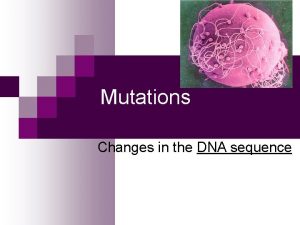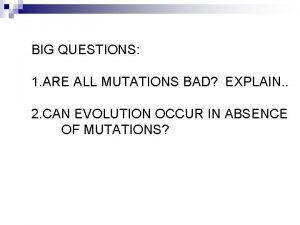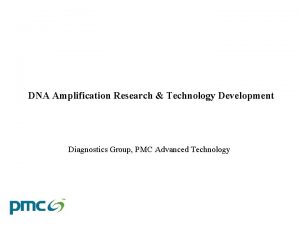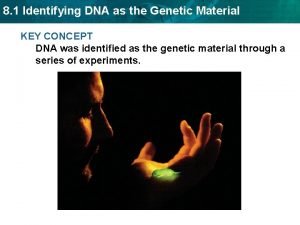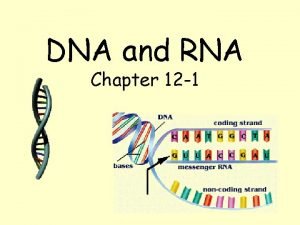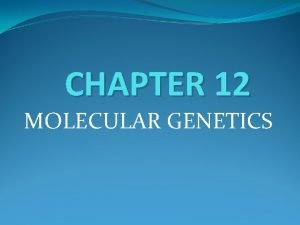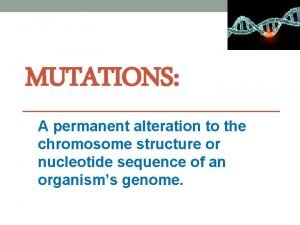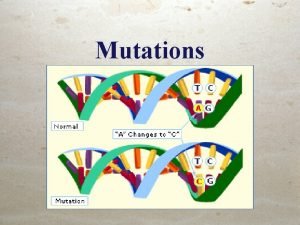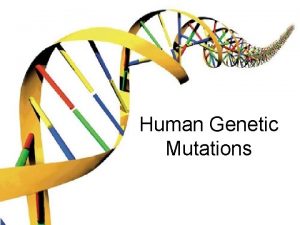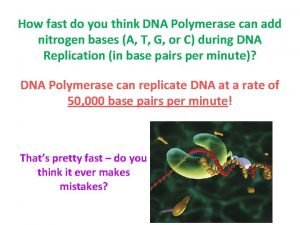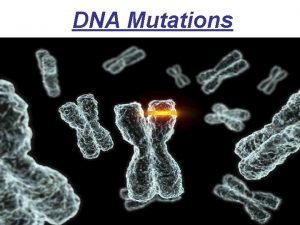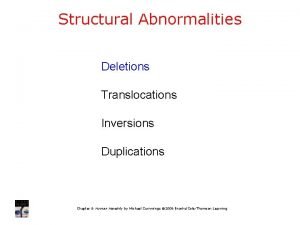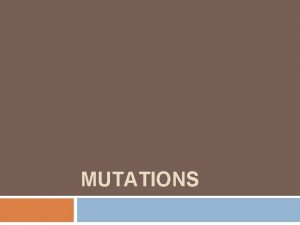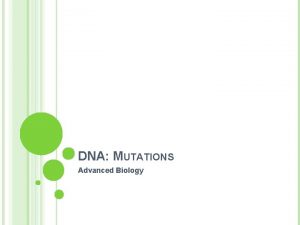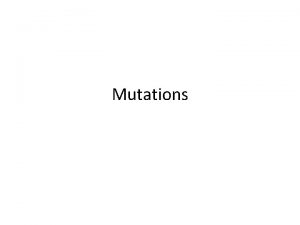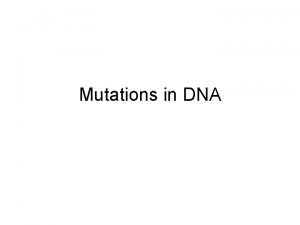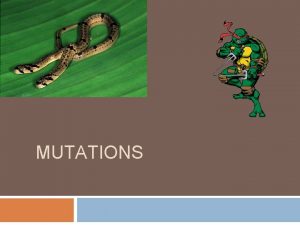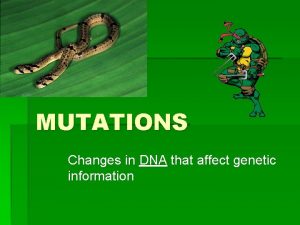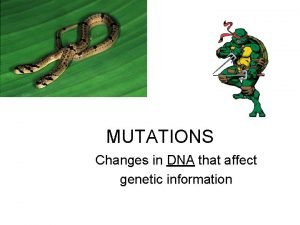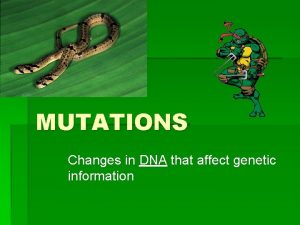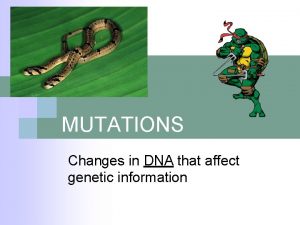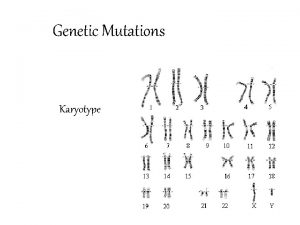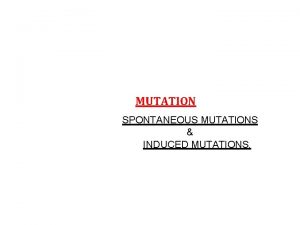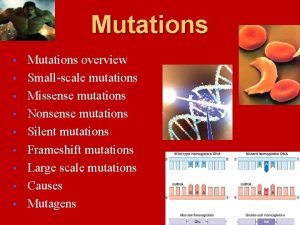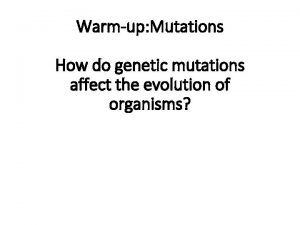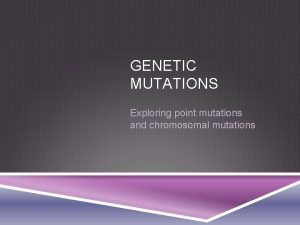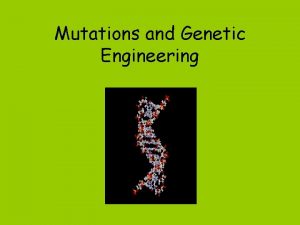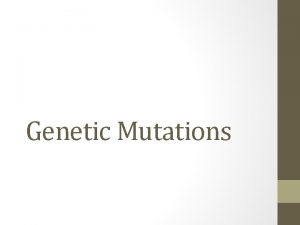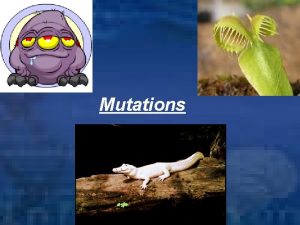MUTATIONS MUTATIONS Changes in DNA that affect genetic







































- Slides: 39

MUTATIONS

MUTATIONS Changes in DNA that affect genetic information

Mutations Changes to DNA are called mutations change the DNA u changes the m. RNA u may change protein u may change trait u DNA TACGCACATTTACG m. RNA AUGCGUGUAAAUGC protein aa aa trait

What Causes Mutations? There are two ways in which DNA can become mutated: Mutations Parent can be inherited. to child Mutations can be acquired. Environmental damage Mistakes when DNA is copied

Are Mutations Helpful or Harmful? Mutations happen regularly Almost all mutations are neutral Chemicals & UV radiation cause mutations Many mutations are repaired by enzymes

Are Mutations Helpful or Harmful? Some type of skin cancers and leukemia result from somatic mutations Some mutations may improve an organism’s survival (beneficial)

Types of Mutations

Chromosome Mutations May Involve: Changing the structure of a chromosome The loss or gain of part of a chromosome

Chromosome Mutations Five types exist: Deletion Inversion Duplication Translocation Nondisjunction

Deletion Due to breakage A piece of a chromosome is lost

Inversion Chromosome segment breaks off Segment flips around backwards Segment reattaches

Duplication Occurs when a gene sequence is repeated

Translocation Involves two chromosomes that aren’t homologous Part of one chromosome is transferred to another chromosomes

Translocation

Nondisjunction Failure of chromosomes to separate during meiosis Causes gamete to have too many or too few chromosomes Disorders: Down Syndrome – three 21 st chromosomes Turner Syndrome – single X chromosome Klinefelter’s Syndrome – XXY chromosomes


Chromosome Mutation Animation


Chromosome Mutations Down Syndrome Chromosome 21 does not separate correctly. They have 47 chromosomes in stead of 46. Children with Down Syndrome develop slower, may have heart and stomach illnesses and vary greatly in their degree of inteligence.

Chromosome Mutations Cri-du-chat Deletion of material on 5 th chromosome Characterized by the cat-like cry made by cri-du-chat babies Varied levels of mental handicaps

Sex Chromosome Abnormalities Klinefelter’s Syndrome XXY, XXYY, XXXY Male Sterility Small testicles Breast enlargement

Sex Chromosome Abnormalities XYY Syndrome Normal male traits Often tall and thin Associated with antisocial and behavioral problems*

Sex Chromosome Mutations Turner’s Syndrome X Female sex organs don't mature at adolescence sterility short stature

Sex Chromosome Mutations XXX Trisomy X Female Little or no visible differences tall stature learning disabilities limited fertility

Gene Mutations Change in the nucleotide sequence of a gene May only involve a single nucleotide May be due to copying errors, chemicals, viruses, etc.

Types of Gene Mutations Include: Point Mutations Substitutions Insertions Deletions Frameshift

Point Mutation Change of a single nucleotide Includes the deletion, insertion, or substitution of ONE nucleotide in a gene

Point Mutation Sickle Cell disease is the result of one nucleotide substitution Occurs in the hemoglobin gene

Frameshift Mutation Inserting or deleting one or more nucleotides Changes the “reading frame” like changing a sentence Proteins built incorrectly

Frameshift Mutation Original: fat cat ate the wee rat. Frame Shift (“a” added): The fat aca tat eth ewe era t. The

Amino Acid Sequence Changed

Gene Mutation Animation

KARYOTYPE ANALYSIS

Normal Male 2 n = 46 34

Normal Female 2 n = 46 35

Male, Trisomy 21 (Down’s) 2 n = 47 36

Female Down’s Syndrome 2 n = 47 37

Klinefelter’s Syndrome 2 n = 47 38

Turner’s Syndrome 2 n = 45 39
 Dna types of mutations
Dna types of mutations Silent mutation
Silent mutation Mutations in dna
Mutations in dna Gene flow vs genetic drift
Gene flow vs genetic drift Genetic programming vs genetic algorithm
Genetic programming vs genetic algorithm Genetic programming vs genetic algorithm
Genetic programming vs genetic algorithm Genetic drift
Genetic drift Gene flow vs genetic drift
Gene flow vs genetic drift Hãy nói thật ít để làm được nhiều
Hãy nói thật ít để làm được nhiều Thơ thất ngôn tứ tuyệt đường luật
Thơ thất ngôn tứ tuyệt đường luật Gây tê cơ vuông thắt lưng
Gây tê cơ vuông thắt lưng Phân độ lown
Phân độ lown Walmart thất bại ở nhật
Walmart thất bại ở nhật Sau thất bại ở hồ điển triệt
Sau thất bại ở hồ điển triệt Block xoang nhĩ độ 2 type 1
Block xoang nhĩ độ 2 type 1 Tìm độ lớn thật của tam giác abc
Tìm độ lớn thật của tam giác abc Thơ thất ngôn tứ tuyệt đường luật
Thơ thất ngôn tứ tuyệt đường luật Tôn thất thuyết là ai
Tôn thất thuyết là ai Chapter 12 section 1: dna: the genetic material
Chapter 12 section 1: dna: the genetic material Section 1 identifying dna as the genetic material
Section 1 identifying dna as the genetic material Chapter 12 section 1 dna the genetic material
Chapter 12 section 1 dna the genetic material Chapter 12 dna the genetic material
Chapter 12 dna the genetic material Chapter 12 section 1 dna the genetic material
Chapter 12 section 1 dna the genetic material Section 12-1 dna
Section 12-1 dna Elizabeth mulroney
Elizabeth mulroney Sample of chemical changes
Sample of chemical changes Chromosomal mutations
Chromosomal mutations Replication fork
Replication fork Enzyme involved in dna replication
Enzyme involved in dna replication Bioflix activity dna replication nucleotide pairing
Bioflix activity dna replication nucleotide pairing Dna and genes chapter 11
Dna and genes chapter 11 Coding dna and non coding dna
Coding dna and non coding dna Chapter 14 lesson 4 mutations
Chapter 14 lesson 4 mutations A mutation is any mistake or change in the
A mutation is any mistake or change in the Mutagens
Mutagens Types of chromosomal mutations
Types of chromosomal mutations Protein synthesis and mutations
Protein synthesis and mutations What are some neutral mutations
What are some neutral mutations Types of mutation
Types of mutation Non reciprocal translocation
Non reciprocal translocation
